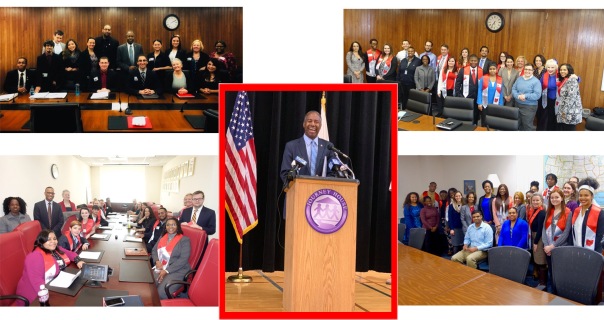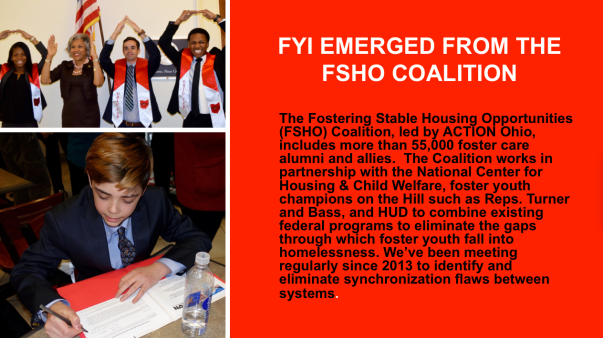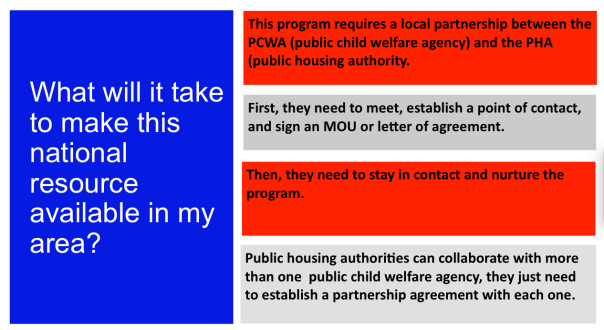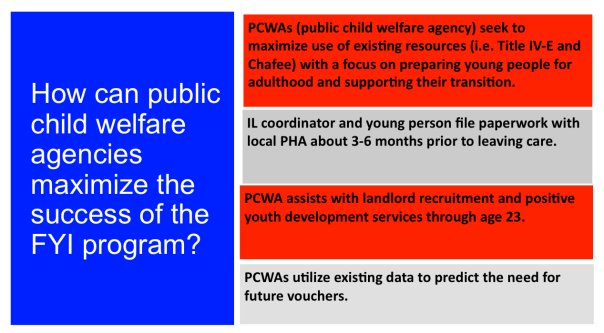
Foster Youth to Independence (FYI) Initiative
We offer our heartfelt gratitude to HUD Secretary Ben Carson and his staff for making this resource possible:
- Ben Carson’s Op-Ed about FYI
- FYI combats homelessness for former foster youth
- Christian’s experience with FYI
- Heidi’s experience with FYI

Since 2013, the FSHO Coalition, led by ACTION Ohio, has worked in partnership with the National Center for Housing and Child Welfare (NCHCW), elected officials including foster youth champions, Reps. Turner and Bass, and the U.S. Department of Housing and Urban Development (HUD) to design a way to weave together existing federal programs in order to eliminate the gaps through which foster youth fall into homelessness.
The FSHO Coalition discovered that the best way to eliminate gaps is to synchronize existing programs such as HUD’s Family Unification Program (FUP), with the predictable nature of emancipation (the date a young person leaves state custody). FYI allows all local Public Housing Authorities to provide an “on demand” FUP voucher that is timed with a young person’s emancipation from foster care. In this way, existing federal resources can be knitted together and used as a platform for economic success.

1.) What is the Foster Youth Independence Program (FYI)?
FYI stands for the Foster Youth Independence Program. This program provides on-demand housing vouchers to public housing authorities to prevent or end homelessness among young adults under age 25, with a history of foster care, including:
- foster family homes
- foster homes of relatives
- group homes, emergency shelters, residential facilities
PCWA must certify that the youth is at least 18 years old and not more than 24 years old (has not reached his/her 25th birthday), that he/she left foster care at age 16 or older or will leave foster care within 90 days, in accordance with a transition plan, and is homeless or at risk of homelessness.
2.) How does this program differ from FUP?
Family Unification Program (FUP) vouchers for youth are only administered by certain public housing authorities throughout the nation. The timing of when these vouchers arrive doesn’t always match the timing of youth need; we call this, “the synchronicity problem.”
But FYI allows every PHA in the nation to administer the program, and these youth vouchers can be issued on demand, because they come from the Tenant Protection Fund, and vouchers from this account (TPVs) can be issued “on demand” at the discretion of the HUD Secretary.
3.) What will it take to make FYI vouchers available in my area?
This program requires a local partnership between the PCWA (public child welfare agency) and PHA (public housing authority). First, they need to meet, establish a point of contact, and sign an MOU or letter of agreement. Then, they need to stay in contact and nurture the program.
Here is a Sample MOU, in PDF and MS Word formats.
Here is a Detailed Briefing Paper from HUD, and a link to Frequently Asked Questions. Please bring these two documents to future meetings to discuss this initiative.
4.) After an agreement is signed, how does the program work?
Here is a link to some diagrams to help understand the process.

Child welfare representatives can maximize results by:
- Utilizing a variety of independent living funding sources to prepare young people who are likely to transition from foster care to adulthood, such as IV-E, Chafee, and workforce funds.
- As young people move along this continuum of services, PCWA staff should monitor if a young person is at risk of homelessness and interested in the stability of renting their own apartment.
- If it is the case that a young person will not be able to afford to rent an apartment without a government subsidy then, the PCWA staff will notify their peer at the local PHA about three to six months prior to emancipation (in most states this is just before age 21) that the young person is eligible for and interested in an FYI voucher.
- PCWAs should also begin to forecast and predict how many young people will need vouchers within their caseload so that they can request vouchers in batches from their local PHA.
- If your state has extended foster care supports to age 21, it is recommended that these supports be utilized first. Then refer the young person to FYI within 30 days of their 21st birthday. This makes the best use of existing resources, and provides a continuum of supports between ages 18-25, to support the young person’s success.